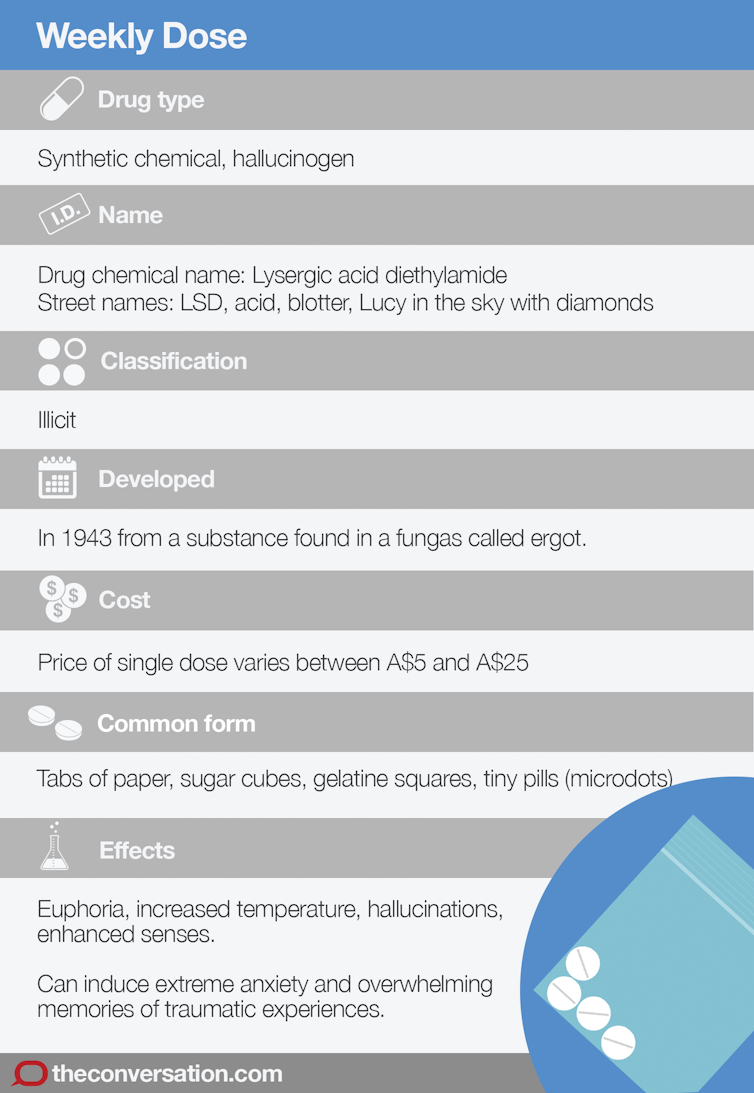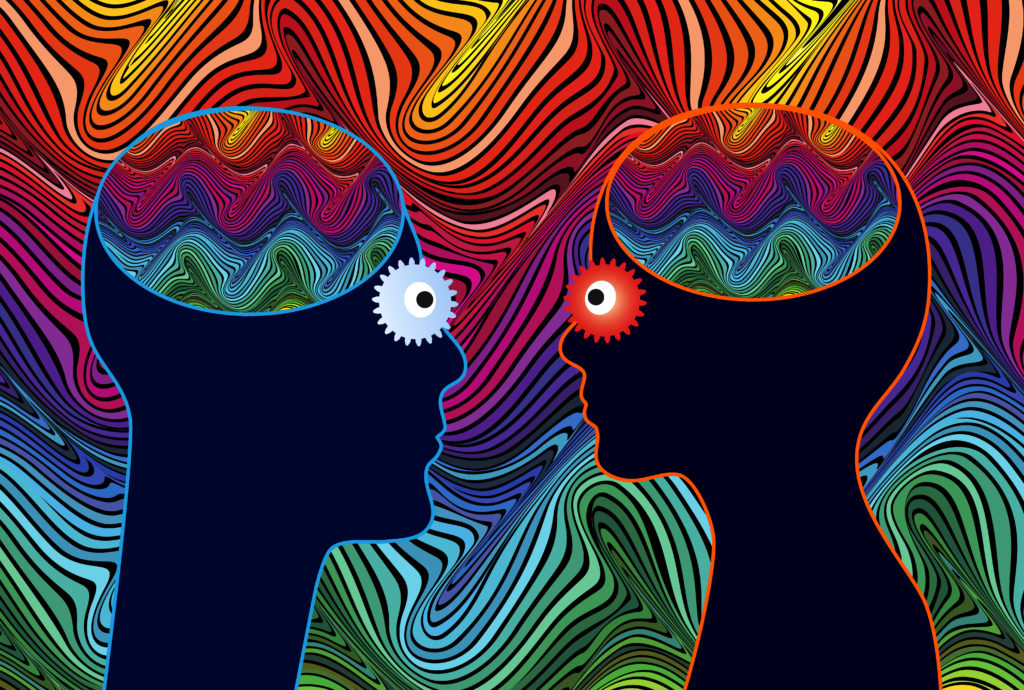Lysergic acid diethylamide (LSD) is a synthetic chemical made from a substance found in a fungus that grows on rye and other grains, called ergot.
In 1943, Swiss scientist Albert Hofmann – who was interested in the medicinal properties of plants – altered a molecule in the fungus hoping to create something that would stimulate blood circulation. But by testing the compound on himself, he discovered he had created a hallucinogen instead.
Today, LSD is an illicit substance used recreationally for its hallucinogenic effects.

How is it used?
LSD is a white powder with no smell. A tiny amount is mixed with liquid and soaked into blotting paper, sugar cubes, gelatine squares and tiny pills called microdots; or squeezed out of a dropper and swallowed; or held under the tongue.
LSD takes 30 to 60 minutes to have an effect, which is called a trip. A trip can last from four to 12 hours and is characterised by feelings of euphoria, increased body temperature and hallucinations, where some or all of the senses are distorted. Time may seem to pass slowly or quickly, colours are enhanced, smells are stronger and thoughts are intense.
A trip can be positive or negative. A bad trip can include overwhelming memories of traumatic experiences, increased anxiety, or fear of people or things in the environment. A person’s mood, the setting and the dose will influence the experience of LSD.
History of use
During the 1950s and 1960s, LSD was used more for psychotherapy than recreation. Between 1950 and 1965, 40,000 people were treated with LSD (under the brand name Delysid) for alcoholism, depression, schizophrenia, autism and homosexuality.
In the United States, psychotherapists used low doses of LSD to enhance the standard therapeutic process. In Europe, psychologists used higher doses to induce a mystical experience and emotional release, believing this would reduce anxiety and depression.
Scientific reports on the effectiveness of either approach are limited.
Most LSD-assisted psychotherapy stopped when increased recreational use led to it being made illegal in the United States in 1966. In 1967, the World Health Organisation recommended LSD become a controlled substance.
How does it work?
Limited research has been conducted into how LSD produces its psychoactive effects. One study on psilocybin, the hallucinogenic substance in magic mushrooms, found it led to decreased activity and connections in the brain, as well as causing changes in blood flow. The link to blood flow suggests Hofman’s theory about LSD affecting circulation could be true.

Pixabay
Other scientists have suggested LSD affects the brain’s serotonin receptors that regulate moods, appetite, sex drive and perception.
It it dangerous?
LSD is not physically addictive. Tripping on a regular basis, and therefore relying on the drug to have a good time, can lead to psychological dependence.
There have been many reports of phenomena termed acid flashbacks – bouts of psychedelic-like perception long after the drug’s effects have work off. Although the flashback is frequently described by people who have used LSD, it has not been well researched or understood.
Except in the case of a pre-existing mental illness, there is little evidence of LSD having a negative, long-term impact on mental health.
The biggest risks associated with LSD are accidents and injuries during trips because of distorted perceptions and feelings of immortality that can lead to risk-taking behaviour.
Reports of overdose are rare. In 1973, eight people were taken to hospital after snorting several milligrams of a powder they thought was cocaine but was actually LSD. They passed out and were hospitalised with high temperatures, internal bleeding and vomiting; although all recovered within 12 hours.
However, a more powerful hallucinogenic sometimes sold as LSD – called 251-NBOMe, 251 or N-bomb – has caused a number of deaths around the world including in Australia, both from overdose as well as accidents and injuries.
How many people use it?
A survey found that in 2013, around 1.3% of the Australian population, or 299,000 people over 14 years of age, had used a hallucinogen in the previous 12 months. This includes LSD and other drugs that cause hallucinations such as magic mushrooms.
The rate of use has not changed much over time, although it was recorded as 3% of the population in 1998.
How much does it cost?
The price of a single dose varies between A$5 and A$25. An average dose is thought to be 0.001 of a gram, althoough 20 to 30 micrograms (a millionth of a gram) can produce an effect.
Like most illicit drugs, the amount of LSD in a purchased dose is unknown.
Other points of interest
A controversial psychologist Timothy Leary was sacked from Harvard University for using LSD in experiments, and recreationally with students.
In response to supply restrictions, in 1967, Leary founded The League for Spiritual Discovery, a religion that claimed LSD as a holy sacrament that should be legal as a religious freedom. United States president at the time, Richard Nixon, called Leary the most dangerous man in America.
Leary wasn’t the only one who believed LSD caused religious or mystical experiences. Many people in the 1960s sought such experiences from LSD, and were sometimes called psychonauts.
Aldous Huxley, author of the dystopian novel Brave New World, regularly used and wrote about psychoactive substances such as LSD and mescaline, a cactus-obtained hallucinogen. He thought LSD was valuable for those who didn’t have a talent for visionary experiences; the kinds necessary to produce great works of art.
Indeed, great artists such as The Beatles did a lot to popularise LSD; with their song Tomorrow Never Knows quoting directly from a book co-authored by Timothy Leary.
Interest in the medical uses of hallucinogens continues. A 2014 study in Switzerland reported participants’ anxiety was reduced following two LSD-assisted psychotherapy sessions.
In Australia, an anaesthetic called ketamine – which causes hallucinations – is being trialled to see if it helps people with depression.
Julaine Allan, Senior Research Fellow, Charles Sturt University
This article was originally published on The Conversation. Read the original article.
![]()

